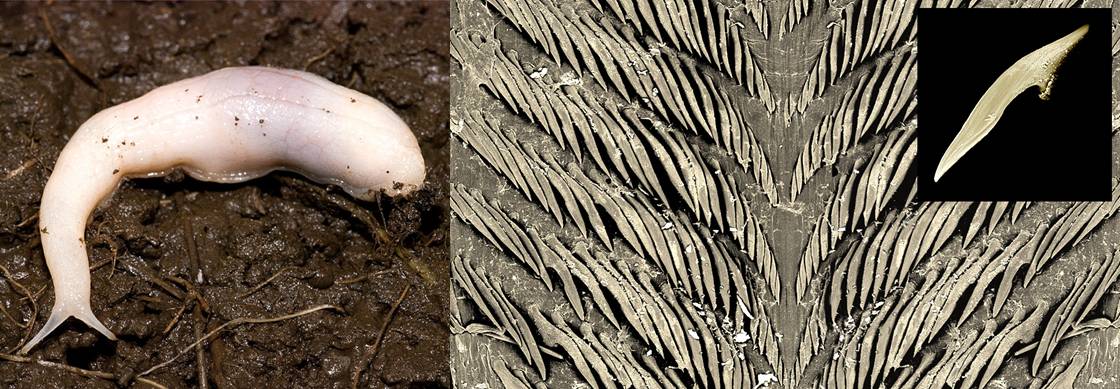The taxonomists also are issuing an SOS – State of Observed Species – report card on human knowledge of Earth's species. In it, they report that 18,516 species new to science were discovered and described in 2007. The SOS report was compiled by ASU's International Institute for Species Exploration in partnership with the International Commission on Zoological Nomenclature, International Plant Names Index, Zoological Record published by Thomson Reuters, and the International Journal of Systematic and Evolutionary Microbiology.
#6 Selenochlamys ysbryda - Welsh Rare Bit

Adult Ghost Slug and it's blade-like teeth each about 0.5mm long. Photos courtesy of Ben Rowson
Name: Selenochlamys ysbryda
Common Name: Ghost Slug
Family: Trigonochlamydidae
How it made the list: This charismatic, introduced species was a surprising find in such a well-collected and densely populated area.
Reference: Rowson, B.&W.O.C. Symondson. 2008. Selenochlamys ysbryda sp. nov. from Wales, UK: A Testacella-like slug new to Western Europe (Stylommatophora: Trigonochlamydidae). Journal of Conchology 39(5):537-552.
Type material: "Holotype (one adult, dissected): UK: Wales: Glamorgan: Cardiff: domestic garden in Canton (ST1676), 10-15m alt., leg. P. Thomas 28 Sep 2007, det. B. Rowson&W. O. C. Symondson (NMW.Z.2008.005.00001; 80% ethanol). S. ysbryda sp. nov., Paratype 1 (one adult, dissected): UK: Wales: Glamorgan: Cardiff: domestic garden in Canton (ST1676), 10-15m alt., leg. B. Rowson 8 Oct 2007, det. B. Rowson&W. O. C. Symondson (NMW.Z.2008.005.00002; 80% ethanol)." [For additional paratypes see Rowson&Symondson (2008)].
Type locality: Cardiff, Glamorgan, Wales, UK.
Etymology: "Specific epithet ysbryda, from Welsh “ysbryd,” a ghost or spirit, latinized by the addition of a feminine ending 'a' and to be treated as a noun in apposition. The name alludes to the species’ ghostly appearance, nocturnal, predatory behaviour and the element of mystery surrounding its origin."
#5 Opisthostoma vermiculum - A Snail that's Whorls Apart
Shell of Opisthostoma vermiculum. Photo courtesy of Reuben ClementsName: Opisthostoma vermiculum
Common Name: None
Family: Diplommatinidae
How it made the Top 10: This species represents a unique morphological evolution in its manner of shell twisting. Most gastropod shells tightly coil according to a logarithmic spiral and have an upper limit of three coiling axes. The shell of O. vermiculum, however, possesses four different coiling axes - the most for any known gastropod. In addition, the whorls detach three times and reattach twice to preceding whorls in a fairly consistent manner, which suggests that the coiling strategy is under some form of strict developmental-gene control. Opisthostoma vermiculum appears to be restricted to a single limestone karst.
Reference: Clements, R., T.-S. Liew, J.J. Vermeulen and M. Schilthuizen. 2008. Further twists in gastropod shell evolution. Biology Letters 4: 179-182.
Type material: "Holotype: ZRC.MOL.002824, Gunung Rapat (4° 33' N, 101° 7' E), Perak, Peninsular Malaysia, held in RMBR. Two paratypes: ZRC.MOL.002825 and ZRC.MOL.002826, same data as holotype."
Type locality: Gunung Rapat, Perak, Malaysia.
Etymology: The specific epithet, vermiculum, is derived from Latin, "meaning wormy."
#4 Chromis abyssus - Nemo's True Blue Cousin
Underwater photo by John Earle; specimen photo by Richard PyleName: Chromis abyssus
Common Name: Deep Blue ChromisFamily: Pomacentridae
How it made the Top 10: The publication in which this new species and four others were described heralded a new era in the taxonomy of animal species. It represented the first taxonomic act of 2008, and the first act registered in the newly launched taxonomic database Zoobank. As a result, the original description was the most downloaded article in Zootaxa's history during its first month, and was among the top ten downloaded articles 11 months in 2008. The discovery of the new species also highlights how little we know of deep-reef biodiversity.
Reference: Pyle, R.L., J.L. Earle&B.D. Greene. 2008. Five new species of the damselfish genus Chromis (Perciformes: Labroidei: Pomacentridae) from deep coral reefs in the tropical western Pacific. Zootaxa 1671: 3-31.
Type material: "Holotype. BPBM 40861 (81.6 mm SL), Belau (Palau) Islands; off Ngemelis Island; below and slightly N of Blue Holes caverns (7°8'16.49"N, 134°13'18.5"E): above large rock outcrop, 110 m, hand net, R.L. Pyle, 27 April 2007 [PCMB 3113]. Paratypes. BMNH 2007.10.31.1 (50.2 mm SL) [PCMB 3103]. BPBM 40855 (3; 37.6–98.0 mm SL) [PCMB 3100, 3102]. CAS 225755 (64.1 mm SL) [PCMB 3105]. MNHN 2007.1922 (63.7 mm SL) [PCMB 3104]. USNM 391136 (2; 44.4–90.2 mm SL) [PCMB 3101]. WAM P.32898-001 (64.5 mm SL) [PCMB 3106]. All from same locality as holotype: sand and rubble slope with scattered rock outcroppings, 107–116 m, quinaldine and hand net, R.L. Pyle and B.D. Greene, 25 April 2007."
Type locality: Off the coast of Ngemelis Island, Belau (Palau) Islands.
Etymology: "Named abyssus, a Latinized form of the Greek noun abyssos (meaning 'abyss'), to honor the documentary film Pacific Abyss, produced by the British Broadcasting Corporation (BBC), which funded the expedition on which the type specimens were collected. The vernacular name 'Deep Blue Chromis', a reference to both the life color of this species and the relatively (within the context of the genus) deep-dwelling habits, is suggested instead of the more literally translated 'Abyss Chromis', so as not to imply that the species inhabits depths commonly defined as 'abyssal.'"







Comments